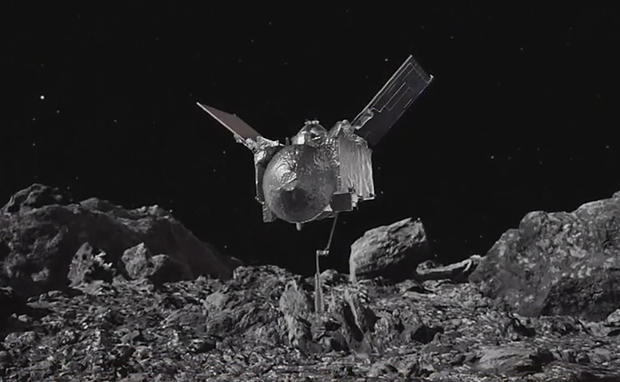NASA To Attempt 16-Second Sample Collection On Asteroid Bennu
LOS ANGELES (CBSLA) — NASA will make a historic attempt to land on an asteroid to grab a sample that will then be delivered back to Earth in 2023.
NASA scientists have been studying the asteroid Bennu for years after discovering it in 1999. Bennu is believed to be 4.5 billion years old and is considered to be a "near-earth object," or NEO, because its trajectory occasionally brings it within a few million miles of Earth's orbit.
"Asteroids are remnants of the early solar system, and the material in them is pristine, not processed," said Mark Clampin, NASA's Goodard director of sciences of exploration. If the mission is successful and the sample is brought back to earth in 2023, it could give scientists clues as to what the solar system was like as it was formed, what chemical building blocks jumpstarted life, how organic material gets transported within the solar system, and what Mars and Venus may have looked like in the past.
The OSIRIS-REx spacecraft was launched in 2016 and reached the proximity of Bennu two years later. Pictures taken by the spacecraft showed scientists the sample collection might be more complicated than anticipated.
"When we first launched OSIRIS-REx, we thought Bennu's surface, this asteroid, would be smooth and sort of beach like," Clampin said. "Turns out that its extremely rugged and rocky, and it's more of a solid beaten rubble pile. So that means we actually have to be very careful as we approach the surface, because the area that we selected for our sample collection, which has a lot of small particles, is surrounded by these big rocks that are around the size of buildings in some cases."
When NASA makes the collection attempt, OSIRIS-REx will break orbit and descend toward Bennu's surface. The plan is for OSIRIS-REx to touch the Bennu for just 16 seconds, using nitrogen gas fired into the robotic collector to stir up and capture some of the asteroid's surface materials. Then the spacecraft will fire its thrusters again and back away from the asteroid.
If the sample collection is successful, OSIRIS-REx is scheduled to depart the asteroid in March 2021 and return to earth in September of 2023. The return capsule containing the sample will separate from OSIRIS-REx and collected in Utah.
A livestream of the historic mission starts at 2 p.m. PST on NASA Television and on NASA.gov.




